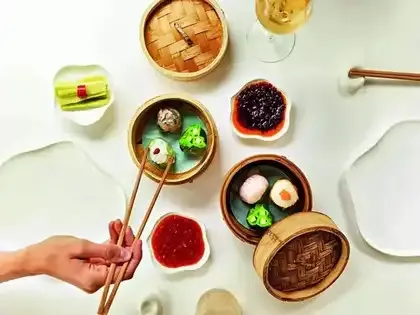GoI's decision to resume tourist visas for Chinese citizens after a gap of five years has multiple dimensions. It's a bold move, because New Delhi risked public disapproval about welcoming Chinese tourists less than three months after China actively helped the Pakistani military to hit Indian targets during the armed conflict in May.
What prompted the decision to enhance people-to-people relations amid distrust towards China, especially among leaders of almost all parties and RSS? This is an important question, because RSS' economic wing, Swadeshi Jagaran Manch, reiterated its call for boycotting Chinese goods as recently as last month.
This is where the plot thickens with some other players, including Donald Trump, entering the picture. A good thing about the Trump regime is that it reminds you at every turn that there are no permanent friends or foes in international affairs. This lesson applies to both superpowers from the Indian standpoint.
The visa decision came after S Jaishankar's July 14 meeting with his Chinese counterpart Wang Yi, an astute diplomat known for his decade-long campaign against a US-dominated order, in Beijing. Last month, China welcomed Indian pilgrims for Kailash Mansarovar Yatra. Direct flights between two countries are expected to resume.
There are clear signs that the prickly relationship is undergoing subtle changes. China issued 85,000 visas to Indians between January 1 and April 9, in addition to reducing visa charges and relaxing certain procedures. 'Welcome more Indian friends to visit China, and experience an open, safe, vibrant, sincere and friendly China,' Chinese ambassador to India Xu Feihong posted on X.
Is India likely to relax restrictions on Chinese investments that were imposed after the 2020 Galwan clash? Last week, Nirmala Sitharaman indicated the possibility of stepping up India-China business engagement with a 'sense of caution'. NITI Aayog recently suggested that Chinese entities may be allowed to invest up to 24% in Indian companies without need for additional security clearances.
One hurdle is the reluctance of Chinese companies to share technology, which is similar to the attitude of Western firms. This is an area where diplomatic dexterity is tested.
India needs to carefully consider the risks of alienating China and relying heavily on Trump, who is now asking US companies not to hire Indian tech workers. He recently asked Apple to pull out of India. Fate of the upcoming trade deal remains uncertain, giving sleepless nights for company executives dependent on the US market.
There is a lot to gain by collaborating with China, which is either competing or racing ahead of the US in several hi-tech areas, besides being the 'factory of the world'. It is any day better to collaborate in the use of AI and robotics in civilian areas than worry about their military applications.
This is a good time for India to press ahead with its demands. There are signs that a section of Chinese experts is asking Beijing to re-examine the commitment of its 'iron brother', Pakistan. This is significant, because Pakistan has proved useful when it comes to keeping India on tenterhooks with a range of border and terrorism-related challenges.
Beijing has multiple different reasons to worry about Pakistan's growing proximity to the US. There is suspicion that US intelligence has access to designs and technical details of Chinese weapons, including anti-missile systems that are with the Pakistani military. China is extremely sensitive about this issue.
Last month, Pakistan formally recommended Trump for the Nobel Peace Prize due to what it described as his 'stellar statesmanship' in resolving the conflict with India in May. Pakistan, one of the world's poorest countries, caused a bit of stir last April when it agreed to buy a cryptocurrency issued by a Trump family trust. To imagine that Beijing would not be alarmed by this development would be to underestimate China's strategic capability.
Trump's invitation to Asim Munir, Pakistan's military chief, to the White House in mid-June had already raised eyebrows. There is some suspicion that Munir is seeking support from both the US and China to take over the reins of power in Islamabad. He was in Beijing last week trying to reassure China of his sincerity to protect Chinese workers and assets from repeated assaults by Baluchi militants. Chinese officials are likely to have quizzed Munir on several issues, including concerns over possible leakage of technical details about China-made weapons.
Questions are often asked about what attracts successive American presidents to Pakistan. The answer lies in its unique geography bordering four countries - China, Russia, Afghanistan and Iran - which are less than friendly towards the US. The strategic advantage of having political influence across China's troubled province of Xinjiang is huge. It can keep China on tenterhooks even if US influence is restricted to intelligence operatives, and does not enlarge into a military presence. Pakistan, which had earlier allowed US military a passage to Afghanistan, would have no qualms about doing the favour once again, this time near the Chinese border.
The Chinese leadership is unlikely to reveal its growing disaffection towards Pakistan. It has spent years convincing its people that the China-Pakistan friendship is cast in iron. But it may be less interested in using Pakistan against India now, as it watches political changes in Islamabad.
What prompted the decision to enhance people-to-people relations amid distrust towards China, especially among leaders of almost all parties and RSS? This is an important question, because RSS' economic wing, Swadeshi Jagaran Manch, reiterated its call for boycotting Chinese goods as recently as last month.
This is where the plot thickens with some other players, including Donald Trump, entering the picture. A good thing about the Trump regime is that it reminds you at every turn that there are no permanent friends or foes in international affairs. This lesson applies to both superpowers from the Indian standpoint.
The visa decision came after S Jaishankar's July 14 meeting with his Chinese counterpart Wang Yi, an astute diplomat known for his decade-long campaign against a US-dominated order, in Beijing. Last month, China welcomed Indian pilgrims for Kailash Mansarovar Yatra. Direct flights between two countries are expected to resume.
There are clear signs that the prickly relationship is undergoing subtle changes. China issued 85,000 visas to Indians between January 1 and April 9, in addition to reducing visa charges and relaxing certain procedures. 'Welcome more Indian friends to visit China, and experience an open, safe, vibrant, sincere and friendly China,' Chinese ambassador to India Xu Feihong posted on X.
Is India likely to relax restrictions on Chinese investments that were imposed after the 2020 Galwan clash? Last week, Nirmala Sitharaman indicated the possibility of stepping up India-China business engagement with a 'sense of caution'. NITI Aayog recently suggested that Chinese entities may be allowed to invest up to 24% in Indian companies without need for additional security clearances.
One hurdle is the reluctance of Chinese companies to share technology, which is similar to the attitude of Western firms. This is an area where diplomatic dexterity is tested.
India needs to carefully consider the risks of alienating China and relying heavily on Trump, who is now asking US companies not to hire Indian tech workers. He recently asked Apple to pull out of India. Fate of the upcoming trade deal remains uncertain, giving sleepless nights for company executives dependent on the US market.
There is a lot to gain by collaborating with China, which is either competing or racing ahead of the US in several hi-tech areas, besides being the 'factory of the world'. It is any day better to collaborate in the use of AI and robotics in civilian areas than worry about their military applications.
This is a good time for India to press ahead with its demands. There are signs that a section of Chinese experts is asking Beijing to re-examine the commitment of its 'iron brother', Pakistan. This is significant, because Pakistan has proved useful when it comes to keeping India on tenterhooks with a range of border and terrorism-related challenges.
Beijing has multiple different reasons to worry about Pakistan's growing proximity to the US. There is suspicion that US intelligence has access to designs and technical details of Chinese weapons, including anti-missile systems that are with the Pakistani military. China is extremely sensitive about this issue.
Last month, Pakistan formally recommended Trump for the Nobel Peace Prize due to what it described as his 'stellar statesmanship' in resolving the conflict with India in May. Pakistan, one of the world's poorest countries, caused a bit of stir last April when it agreed to buy a cryptocurrency issued by a Trump family trust. To imagine that Beijing would not be alarmed by this development would be to underestimate China's strategic capability.
Trump's invitation to Asim Munir, Pakistan's military chief, to the White House in mid-June had already raised eyebrows. There is some suspicion that Munir is seeking support from both the US and China to take over the reins of power in Islamabad. He was in Beijing last week trying to reassure China of his sincerity to protect Chinese workers and assets from repeated assaults by Baluchi militants. Chinese officials are likely to have quizzed Munir on several issues, including concerns over possible leakage of technical details about China-made weapons.
Questions are often asked about what attracts successive American presidents to Pakistan. The answer lies in its unique geography bordering four countries - China, Russia, Afghanistan and Iran - which are less than friendly towards the US. The strategic advantage of having political influence across China's troubled province of Xinjiang is huge. It can keep China on tenterhooks even if US influence is restricted to intelligence operatives, and does not enlarge into a military presence. Pakistan, which had earlier allowed US military a passage to Afghanistan, would have no qualms about doing the favour once again, this time near the Chinese border.
The Chinese leadership is unlikely to reveal its growing disaffection towards Pakistan. It has spent years convincing its people that the China-Pakistan friendship is cast in iron. But it may be less interested in using Pakistan against India now, as it watches political changes in Islamabad.
(Disclaimer: The opinions expressed in this column are that of the writer. The facts and opinions expressed here do not reflect the views of www.economictimes.com.)






Saibal Dasgupta
Author of Running with the Dragon: How India Should Do Business with China